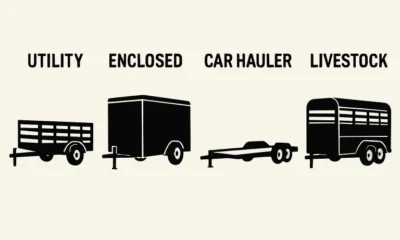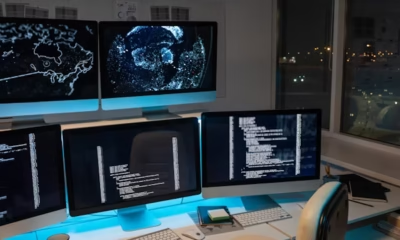Business
Optimizing Your Order Fulfillment Process – A Step-By-Step Guide

If you are interested in optimizing your order fulfillment process, there are several steps that you can take. You can use a hybrid approach to fulfilling orders or implement automation into your system. Regardless of your chosen strategy, ensuring that your customers receive a positive experience is the most important thing.
Automated order-picking systems
A well-organized order-picking system will improve the efficiency of your warehouse. In addition, it will keep you on track to fulfilling orders.
When it comes to automated warehouse order-picking systems, there are a variety of options. Whether you have a small or large warehouse, these solutions will help your workers pick and pack your orders precisely.
With the rise of eCommerce, the order-picking process has become more competitive. The increased demands of consumers have made it more critical for companies to have a fast delivery time and a high order mix. It means you must have a system that can handle many orders simultaneously.
Using robotic forklifts or collaborative mobile robots will enhance the speed at which you move inventory. It will also reduce the time your workers spend moving products around the warehouse.
Order picking can be one of the most costly and time-consuming parts of a warehouse’s fulfillment operation. An automated system will eliminate mistakes during the picking process and improve overall efficiency.
Another way to increase picking productivity is to minimize travel time. During picking, the selector may spend as much as sixty percent of their time walking. By implementing a consolidated order list, workers can stay on top of the number of orders they are picking and concentrate on the items they need to complete each order.
A hybrid approach to fulfillment
Consider using a hybrid approach to order fulfillment processes to grow your firm. It’s a versatile way to deal with supply shortages and satisfy client requests.
A third-party logistics provider (or 3PL) offers a dependable way to manage your e-commerce business’s inventory and shipping. They also provide technology integrations to help your business connect the dots between different fulfillment channels. With a reliable third-party logistics provider, you can save time and resources while ensuring your customers receive the products they need on time.
Hybrid fulfillment can be a smart move for businesses that are scaling fast and must find the most cost-effective means of delivering their products. The best part about this type of strategy is that it frees up your time and resource to focus on other aspects of your business.
Many e-commerce businesses are turning to outsourced fulfillment as a cost-effective way to streamline their operations. The benefits of this approach include a more efficient supply chain and a more flexible order fulfillment process. But while it can help businesses cut costs, it can also lead to unintended consequences.
One of the most common examples of hybrid fulfillment is using Amazon’s FBA service to fill orders. However, this method can take time and effort. It can also require you to pay multiple shipping labels and fees.
Minimize shipping zones
To maximize profit margins and deliver fast, efficient service to customers, it’s vital to minimize shipping zones. E-commerce stores can reduce delivery time and cost by strategically fulfilling orders.
Shipping zones are calculated from a package’s origin to the destination. Shipping costs increase as the distance from the warehouse to the customer increases.
Shipping rates depend on the package type, the box’s weight, and the carrier. Whether an e-commerce store needs to ship outbound or inbound packages, it’s essential to understand shipping zones. Knowing the impact of shipping zones can help a brand get a better picture of how long the box will take to arrive.
A well-planned order fulfillment strategy can be a powerful way to generate more sales. A multi-node approach can store inventory near popular order destinations and improve the process’s speed and efficiency.
For example, Amazon has warehouses across the country. Getting items to customers quickly and accurately can be difficult, however. The company is constantly looking to improve its order fulfillment process.
To determine the best fulfillment location, look at your past order history and pick the places with the high volume of orders. Look for warehouses or fulfillment centers near cities with high customer concentration. It will give your items the fastest transit times possible.
Customer service
The order fulfillment process is a crucial part of your customer service. When your customers get their packages on time, they are more likely to trust you and will return to you in the future. However, when they are not satisfied, they may look for a different store. Therefore, you must optimize your order fulfillment to ensure you deliver the highest possible satisfaction level.
Optimizing your order fulfillment process involves several steps. Firstly, you need to establish a clear list of expectations. It is essential to communicate with your customers when there are delays in the delivery of their orders. Please inform them of the delay as soon as you know. It allows them to work with the timelines you have set for them.
Next, you need to find a shipping carrier. These companies play a significant role in the shipping process and are also responsible for helping to keep your customers happy. If you can build a strong relationship with one of these providers, you will have the ability to get preferential rates and better services. Finally, you need to make sure that you are communicating effectively. After all, your customers are the ones who are paying for your services, and you will want to make them happy.
Business
Hallmarks of a Reputable PLC Programming Company for Controls and Training

High-performing automation depends on more than just hardware—it’s the brains behind the operation that make the difference. A skilled PLC programming company can turn a collection of devices into a responsive, safe, and efficient system. From understanding global programming standards to delivering practical, on-site training, the right team leaves a lasting impact on every project.
Deep Understanding of IEC 61131-3 Programming Standards
A company well-versed in IEC 61131-3 ensures that the programming approach is consistent, scalable, and compatible with industry norms. This standard defines how PLC programming languages—like Ladder Diagram, Structured Text, and Function Block Diagram—are applied, making it easier for technicians across different facilities to read and maintain the code. For clients asking what is PLC programming, this adherence to a universal standard translates into systems that are easier to troubleshoot, upgrade, and share between platforms.
The best PLC programming companies not only follow IEC 61131-3 but apply it with practical, industry-specific logic. They know when to use each language for the most efficient result—whether crafting a safety circuit in Ladder Logic or building complex calculations in Structured Text. That deep understanding keeps systems consistent across plants and prepares them for integration with other technologies, including Rockwell Allen Bradley PLC systems and other major platforms.
Expertise in Modular PLC Architectures for Diverse Industry Needs
Modular PLC designs allow systems to adapt quickly as production needs change. A company with expertise in modular architectures can build control systems that are easily expanded or reconfigured without overhauling the entire setup. This is especially valuable for operations that need flexibility to add new processes or equipment down the line.
For clients seeking a custom PLC solution, modular architectures keep costs down over the long term by avoiding complete rewrites. A skilled PLC programming company can break a project into functional modules—each responsible for a specific part of the process—making updates and maintenance far simpler. Whether it’s food processing, manufacturing, or water treatment, modular design ensures that changes won’t mean starting from scratch.
Proven Ability to Craft Responsive and Fault-Tolerant Control Logic
Responsive control logic means equipment reacts instantly to operator input and process changes, without lag or overshoot. Fault-tolerant logic goes further, ensuring that even if a device fails or a sensor drops out, the system continues to operate safely. A reputable PLC programming company understands both concepts deeply and builds them into every project.
This ability isn’t just about writing code—it’s about anticipating real-world problems. By combining robust error handling with efficient scan cycles, they can deliver PLC programming that’s resilient under pressure. In industries where downtime means thousands of dollars lost per minute, this level of programming skill is essential to keeping production moving smoothly.
Skill in Integrating PLC Systems Seamlessly into Broader Automation Setups
Modern automation rarely operates in isolation. PLCs must work hand-in-hand with HMIs, SCADA systems, motion controllers, and robotics. A capable PLC programming company understands these connections and can integrate PLC systems into broader automation networks without conflicts or communication breakdowns.
This integration skill is particularly important when working with Rockwell Allen Bradley PLC systems, as they often serve as the backbone for multi-vendor setups. A team with the right experience can configure network protocols, synchronize data sharing, and ensure that the entire system responds as one unified operation. That seamless flow is the hallmark of a well-executed control system.
Adaptability Across Different Industry Applications via Tailored Programming
No two industries require the same control logic. What works for a bottling plant won’t necessarily suit a packaging line or a wastewater facility. A reputable PLC programming company adapts its approach to fit the unique demands of each industry. That adaptability comes from experience and a willingness to build truly tailored solutions.
Tailored programming often means writing code that not only runs the process but also accounts for specific safety regulations, environmental conditions, and operator skill levels. For a custom PLC project, the company’s ability to listen, interpret, and translate client requirements into reliable logic makes all the difference between a functional system and an exceptional one.
Use of Real-Time Diagnostics for Proactive System Monitoring
Real-time diagnostics allow operators and maintenance teams to spot issues before they cause downtime. A skilled PLC programming company builds these diagnostic features directly into the control logic, so the system can monitor itself and send alerts for potential problems. This could include flagging unusual sensor readings, cycle delays, or mechanical wear indicators.
With built-in diagnostics, teams can plan maintenance instead of reacting to breakdowns. Whether on a Rockwell Allen Bradley PLC or another platform, these features extend equipment life, improve safety, and keep production on schedule. It’s a proactive approach that shows the company’s commitment to long-term system performance.
Strong Track Record of Streamlined Commissioning and System Handoff
Even the best code means little without a smooth handoff. A reputable PLC programming company approaches commissioning with precision—testing every input, output, and fail-safe before the system goes live. They document the process thoroughly and provide clear instructions so operators can take over with confidence.
This streamlined transition often includes on-site training that answers the practical question of what is PLC programming in the context of the client’s exact setup. By the time the project wraps, operators aren’t just watching the system run—they’re equipped to run it well. That final step ensures the investment in PLC programming pays off from day one.
Business
A Complete Breakdown of the Certification Assessment from the CMMC DoD Perspective

Keeping data secure in the defense world is no longer a side task—it’s front and center. Cybersecurity Maturity Model Certification (CMMC) is shaping how contractors work with the Department of Defense. If you’re working toward a CMMC Level 2 Certification Assessment, knowing what to expect can make or break your compliance journey.
CMMC Certification Levels Overview from DoD Perspective
From the DoD’s point of view, CMMC is more than a checklist—it’s a trust framework. Each level builds on the last, measuring how well an organization can safeguard sensitive defense data. The focus for most defense contractors is on CMMC Level 2 Assessment, which applies to those handling Controlled Unclassified Information (CUI). This level demands compliance with NIST SP 800‑171, which includes 110 security practices grouped into 14 control families. It’s a big leap from Level 1, which only covers basic safeguarding requirements.
Unlike earlier models, the DoD now mandates third-party assessments for Level 2 under specific contract conditions. This new structure helps prevent overreliance on self-attestations and ensures a more accurate representation of each contractor’s cybersecurity posture. Contractors must demonstrate their ability to protect CUI with evidence-based practices, making the CMMC Certification Assessment a serious, high-stakes event.
Internal Assessment Procedures Anchored in NIST 800‑171 Mapping
Before any third party steps in, companies must run an internal checkup aligned with NIST SP 800‑171. This isn’t about quick reviews—it’s a deep look into your systems, processes, and documentation. You need to cross-check every practice with your current cybersecurity setup, measuring gaps and fixing weak points. That internal effort should result in a mapped, tracked, and measurable compliance trail that reflects real-world application of the NIST controls.
From a CMMC DoD compliance perspective, this internal work isn’t optional. Defense contractors must be able to show that their internal assessment procedures are grounded in real evidence and directly connected to NIST 800‑171 practices. This ensures the organization is ready for a CMMC Level 2 Certification Assessment, which validates both the presence and effectiveness of those controls—not just that they exist on paper.
Third‑Party Assessment Events Conducted by C3PAO Teams
Third-party assessments are the formal gatekeepers for compliance. Certified Third-Party Assessment Organizations (C3PAOs) come into play only when internal preparation is complete. These teams dig into everything—from technical system configurations to staff procedures—to verify that your security practices meet all requirements of the CMMC assessment guide. Their job isn’t just to confirm what’s written, but to validate that controls are working as intended.
C3PAO teams follow a strict process and timeline. They collect objective evidence, conduct interviews, and examine system access controls in detail. Their findings determine whether you pass or need corrective actions. If the CMMC Certification Assessment flags issues, your organization must close the gaps before certification can be granted. For contractors hoping to bid on DoD work, this third-party verification is an absolute must—especially for Level 2 compliance involving CUI.
Pre‑Assessment Readiness Reviews Ensuring Audit Preparedness
Before a formal assessment begins, many contractors opt for a pre-assessment readiness review. This step helps identify holes in security controls and provides a last chance to correct issues before C3PAOs begin their audit. The pre-assessment isn’t just a dry run; it acts like a diagnostic tool that strengthens your overall cybersecurity framework.
Readiness reviews give teams clarity about their current posture. Are access control policies clearly defined? Is encryption properly deployed? Are staff roles documented? These insights help you tighten operations and streamline the evidence collection process ahead of the CMMC Level 2 Assessment. Contractors often find that pre-assessments offer huge value by highlighting issues that might otherwise delay certification.
Scope Definition Strategies Based on Controlled Unclassified Information
Defining the scope of your assessment starts with identifying where Controlled Unclassified Information (CUI) resides. CUI isn’t always obvious—it can be hidden in emails, stored on shared drives, or embedded in applications. Without clear boundaries, the scope balloons and your CMMC Level 2 Certification Assessment becomes a logistical nightmare.
Smart contractors isolate systems that process or store CUI and build security enclaves to simplify the audit scope. This not only reduces costs but also limits the assessment to systems that matter most to the CMMC DoD. Contractors must define and defend the flow of CUI through their environment, and document how that information is accessed, protected, and retained.
Assessment Objective Documentation Requirements per CMU‑SEI Guidance
Every practice in your CMMC assessment has associated objectives—and every objective needs documentation. This includes policies, procedures, technical configurations, training records, and evidence of implementation. CMU-SEI (Carnegie Mellon University Software Engineering Institute) provides guidance that helps align your documentation with DoD expectations, and failing to follow it can hold up your certification.
This documentation must prove that each control is not only implemented, but used effectively. A policy by itself is meaningless unless it’s been communicated, enforced, and monitored. That’s what C3PAO teams look for—real, living proof that your organization isn’t just saying the right things, but doing them. The CMMC assessment guide stresses the importance of objective evidence, making proper documentation a cornerstone of success.
Recertification Cycles and Three‑Year Compliance Validity
Once you’re certified, that’s not the end. Your CMMC status is valid for three years, but it doesn’t mean you can relax. Maintaining compliance means consistently applying the same practices and controls that earned your certification. You’ll need to keep track of any changes in personnel, systems, or infrastructure that could impact security posture.
During the three-year cycle, there may be surveillance checks or targeted follow-ups. If your systems drift away from the security baseline, your standing with the CMMC DoD can be put at risk. Preparing for your next CMMC Certification Assessment should be an ongoing process, not a once-in-a-while scramble. Teams who embed compliance into daily operations are the ones who stay ready year-round, not just every three years.
Business
Harnessing the Power: A Comprehensive Guide to Home Generators for Reliable Backup Energy

Home generators are essential for maintaining household energy flow during power outages, converting mechanical energy into electrical power. They are valuable assets for investors, especially in regions susceptible to storms and infrastructural disruptions, as unexpected power outages can be frustrating. This is where generators become invaluable. Generators are essential backup energy sources for homes, providing uninterrupted power during outages. Understanding their intricacies allows homeowners to make informed decisions about integrating into their energy solutions. These versatile machines ensure safety and comfort during emergencies, and when planned and installed correctly, they become a vital component of a home’s infrastructure.
Types of Home Generators and Their Uses
Understanding the available types is crucial when finding the right generator for your home. There are primarily three categories to consider, each serving distinct purposes:
- Portable Generators: These models are designed for flexibility and immediate use. Portable generators are an excellent option for quick power needs, including electricity for recreational reasons or temporary backup during minor outages. They’re usually powered by gasoline, making them easy to fuel but they require manual setup and start.
- Standby Generators: Standby generators, permanently placed outside the house, start up automatically in the event of a power loss. Because they are directly connected to the home’s electrical system, they guarantee a continuous energy supply that can endure prolonged outages without human involvement. Their robust performance makes them ideal for households where constant power is critical.
- Inverter Generators: Known for their quiet operation, inverter generators are a favorite for those who need efficient, portable energy solutions with minimal noise. They produce cleaner power, making them suitable for sensitive electronics. They are usually lighter in weight for enhanced portability.
The Importance of Backup Power During Emergencies
Power outages are more than an inconvenience—they can pose serious safety risks, especially during extreme weather conditions. A standby generator is essential during emergencies like hurricanes or snowstorms, ensuring that critical appliances such as refrigerators and heating systems remain operational. This preserves perishable goods and provides a safe and comfortable environment. Additionally, maintaining power is vital for communication devices and medical equipment, which can be lifesaving in critical situations. Regular maintenance and electrical repair services help keep backup power sources reliable, offering peace of mind when family safety and comfort are at stake.
Choosing the Right Generator for Your Needs
Deciding which generator to invest in requires a clear assessment of your home’s energy demands and budgetary constraints. Key considerations include the total wattage required by critical appliances and systems, the type of fuel preferred, and acceptable noise levels. Since every home is unique, choosing a generator should be customized to fit your needs without exceeding your financial or technical constraints. Considering these factors, consult an expert to determine the best match for your setup.
Installation Considerations for Home Generators
A proper installation process is critical for maximizing the function and safety of your home generator. This typically involves situating the unit in a well-ventilated area, away from windows or doors, to prevent harmful gas accumulation. It’s essential to ensure compliance with local safety regulations regarding generator placement and operation. Therefore, choosing a certified professional for installation is not just advisable but often necessary to avoid potential hazards and guarantee optimal generator performance.
Maintenance Tips for Optimal Performance
Maintenance is vital to owning a home generator, impacting its functionality and longevity. Routine duties include performing wear and tear checks, replacing fuel and air filters, and checking and changing the oil. Such measures help prevent unexpected breakdowns and ensure the generator is ready to perform when called upon. In addition to extending the equipment’s lifespan, routine maintenance ensures safety and keeps the generator operating well in any situation.
Enhancing Home Safety with Backup Energy
The benefits of home generators extend beyond convenience, significantly enhancing a home’s safety during power outages. Maintaining functional lighting and key security systems gives homes extra protection by lowering the chance of mishaps and discouraging possible burglars. The sense of security a home generator provides is invaluable, ensuring that even in uncertain times, your home remains safe and well-protected.
Future Trends in Generator Technology
With ongoing advancements, generator technology is evolving to become more efficient and environmentally conscious. To lessen dependency on conventional fuels, new trends emphasize the integration of alternative energy sources, such as solar power. Moreover, innovative technology is paving the way for more user-friendly and automated generator systems, which can seamlessly integrate into a home’s existing energy management system. These innovations promise cleaner, more sustainable pathways to ensure that homes remain well-equipped to face energy disruptions now and in the future.
-

 Garden3 weeks ago
Garden3 weeks agoGuide to Choosing the Right Trailer for Your Needs
-

 Travel3 weeks ago
Travel3 weeks agoSouvenir Spotlight: Iconic Keepsakes That Capture the Spirit of Popular Destinations
-

 General2 weeks ago
General2 weeks agoStreamlined & Up-to-Date: Navigating the Simple Steps and Current Requirements to Become a Notary Public
-

 Business5 hours ago
Business5 hours agoHallmarks of a Reputable PLC Programming Company for Controls and Training




